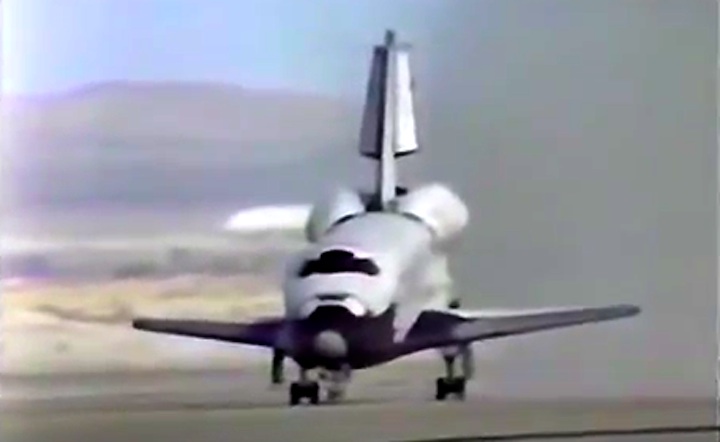.
Mission: Second Shuttle Mission/Office of Space and Terrestrial Applications-1 (OSTA-1)
Space Shuttle: Columbia
Launch Pad: 39A
Launched: Nov. 12, 1981 at 10:09:59 a.m. EST
Launch Weight: 320,708 pounds
Landing Site: Edwards Air Force Base, Calif.
Landing: Nov. 14, 1981 at 1:23:11 p.m. PST
Runway: 23
Rollout Distance: 7,711 feet
Rollout Time: 53 seconds
Revolution: 37
Mission Duration: 2 days, 6 hours, 13 minutes and 12 seconds
Returned to KSC: Nov. 25, 1981
Orbit Altitude: 157 nautical miles
Orbit Inclination: 38.0 degrees
Miles Traveled: 1.075 million
Crew Members

-

Image above: STS-2 Crew photo with Commander Joe H. Engle, Pilot Richard H. Truly and back up crew members, Thomas K. Mattingly II and Henry W. Hartsfield, Jr. Image Credit: NASA
Mission Objectives Demonstrate safe re-launch and safe return of the orbiter and crew. Verify the combined performance of the entire shuttle vehicle - orbiter, solid rocket boosters and external tank.
Demonstrate safe re-launch and safe return of the orbiter and crew. Verify the combined performance of the entire shuttle vehicle - orbiter, solid rocket boosters and external tank.
Payloads included the Orbital Flight Test Pallet consisting of the Measurement of Air Pollution from Satellite (MAPS) experiment, the Shuttle Multispectral Infrared Radiometer (SMIRR) experiment, the Shuttle Imaging Radar (SIR-A) experiment, the Features Identification and Location Experiment (FILE) and the Ocean Color Experiment (OCE). Also included was the 11,048 lb. Development Flight Instrumentation (DFI) pallet, the Aerodynamic Coefficient Identification Package (ACIP), the Induced Environment Contamination Monitor (IECM) and the 5,395 lb. Office of Space and Terrestrial Applications Pallet (OSTA-1).
Mission Highlights
Launch originally set for Oct. 9 was rescheduled when a nitrogen tetroxide spill occurred during loading of the forward reaction control system. The launch scheduled for Nov. 4 delayed and then scrubbed when the countdown computer called for hold in the count due to an apparent low reading on fuel cell oxygen tank pressures. During the hold, high oil pressures were discovered in two of three auxiliary power units (APUs) that operate hydraulic system. APU gear boxes needed to be flushed and filters replaced, forcing the launch to reschedule. The launch on Nov. 12 delayed two hours, 40 minutes to replace the multiplexer/demultiplexer and additional nine minutes, 59 seconds to review systems status.
Modifications of the water sound suppression system at the pad to absorb the solid rocket booster overpressure wave during launch were effective -- no tiles were lost and only 12 were damaged.
The planned five-day mission was cut nearly three days due to failure of one of three fuel cells that produce electricity and drinking water, but 90 percent of mission objectives achieved, including first time remote manipulator system tests. Mission scientists were satisfied with data received from Office of Space and Terrestrial Applications-1 (OSTA-1) Earth observation experiments mounted on Spacelab pallet in payload bay.
-

S81-39499 (13 Nov. 1981) --- President Ronald Reagan is briefed by JSC Director Christopher C. Kraft Jr., who points toward the orbiter spotter on the projection plotter in the front of the mission operations control room in the Johnson Space Center's Mission Control Center. This picture was taken just prior to a space-to-ground conversation between STS-2 crew members Joe H. Engle and Richard H. Truly, who were orbiting Earth in the space shuttle Columbia. Photo credit: NASA
-
Frams von LiftOff STS-2:





































Quelle: NASA
